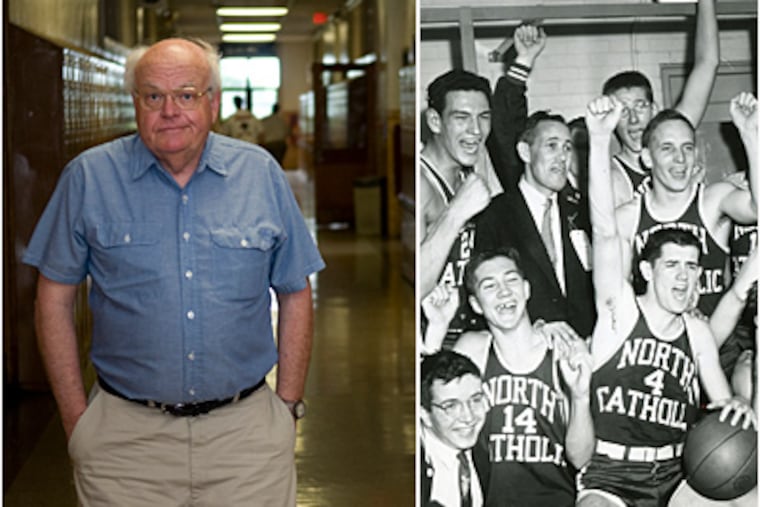As North Catholic closes, so does an era
NORTHEAST CATHOLIC HIGH SCHOOL for Boys in Frankford, which at one point in its 84-year history had the largest male student body of any Catholic high school in the world, holds its final graduation ceremony today.

NORTHEAST CATHOLIC HIGH SCHOOL for Boys in Frankford, which at one point in its 84-year history had the largest male student body of any Catholic high school in the world, holds its final graduation ceremony today.
A few days later, it will close its doors forever.
"With the Class of 2010, there are 39,746 alumni of whom, to the best of our knowledge at this writing, 30,728 are living," Northeast Catholic Alumni Association president John Hanejko reported in April to fellow alumni. About 4,591 alumni are active members, he said.
Well, as an active member of the NECHS Class of 1959, I'm alive, but not well, disheartened since October after the Archdiocese of Philadelphia pronounced North Catholic dead as the proverbial doornail.
The school opened in September 1926, as Philadelphia's fourth Archdiocesan high school, with 277 freshmen and 172 sophomores. By 1953, its enrollment of 4,726 set a world record.
It was always an urban institution, drawing students from blue-collar parishes in the river wards to North Philadelphia and from Nicetown to Germantown in a city that, despite being decimated by a half-century of urban flight, still retains its nickname of the "City of Neighborhoods."
The U.S. Census Bureau reported that Philadelphia in 1960 had more than 2 million residents. By 2006, the bureau estimated that figure had dropped to fewer than 1.5 million residents.
A combination of the shrinkage of residents from neighborhood parishes, where North traditionally secured its students, and the cost of enrolling a teenager into an Archdiocesan high school in today's troubled economy signed the school's death warrant.
I was accepted by North Catholic in 1956 from Nativity BVM Parish in Port Richmond. Students at North from Nativity covered their tuition by selling five raffle tickets a week for the Nativity Parish U-2 Club prize-money drawing.
Tickets were five for $1. A lucky parishioner each week won $500. North got the rest of the cash. My annual tuition for each of four years was $52 a year, underwritten by raffle-ticket sales.
Catholic high-school tuition for 2010-2011 averages $5,000 per student per year, according to a source at the Archdiocese of Philadelphia. This figure doesn't include costs for items such as books and fees for extracurricular activities.
Despite its recent financial challenges, North Catholic remained faithful to its mission mandated by the Oblates of St. Francis de Sales to mold callow youths from Philadelphia street-corner society into young Catholic gentlemen.
Adolescent boys like me daydreamed all through elementary school about going to North. The possibility of attending an industrial neighborhood high school in the shadow of the Frankford El was more exciting than dreams of someday winning a full scholarship to Harvard or Yale.
When I first walked beyond the Corinthian columns framing North's front entrance on Torresdale Avenue more than 50 years ago, memories of an earlier life being taught by the Sisters of Saint Joseph in a parish school faded into oblivion.
The school's nickname was "The Big House," which sounded like a term for a prison in an old Jimmy Cagney gangster movie. You were under the command of the Oblates, The Big Guys who ran The Big House.
And that incarceration was celebrated with glee and reckless abandonment.
You considered yourself the luckiest guy on the face of the earth. The pride you felt for North Catholic was every bit as intense as the pride first baseman Lou Gehrig felt for his beloved New York Yankees.
The Oblates were great teachers in and out of the classroom. In addition to opening our minds through book learning, they made sure we acquired the basic behavior skills necessary to get through life. Or else!
The Rev. Thomas "Knobby" Walsh, the law-and-order Oblate with the heart of gold, was the prefect of discipline who sentenced generations of errant youths who failed to comprehend these lessons on proper behavior to North Catholic's version of Devil's Island.
It was known as JUG, an acronym for "Justice Under God." It meant being kept after school for two hours of more, sometimes as long as 20 days, for felony offenders.
"If you got suspended for smoking, cutting class or acting up on the trolley car, JUG became part of your education at North," Walsh explained in a Daily News interview in 1994.
Like the vitamins and minerals required for good physical health for growing adolescent boys, JUG was necessary for the development of a good moral compass.
"Boys make excuses for their actions; men take responsibility. JUG molds boys into solid young men," Walsh said.
While doing time in JUG, you weren't allowed to read or do homework. Instead, you had to sit still for 120 minutes on a lunchroom stool, reflecting on your errant ways.
During my numerous JUG incarcerations, not being allowed to read or do homework created a conflict with earlier Oblate warnings about an idle mind being the Devil's workshop. An idle mind, they cautioned, likes to play host to impure thoughts and desires.
If my incarceration was only for a day or two, I could fend off Satan and his ways. But once, while doing 20 days, my idle mind did in fact play the role of an eager host, but through no fault of my own.
The Devil made me do it!
Frank Dougherty was a Daily News reporter from 1961 until his retirement in 2001. He is a member of North Catholic's Hall of Fame.